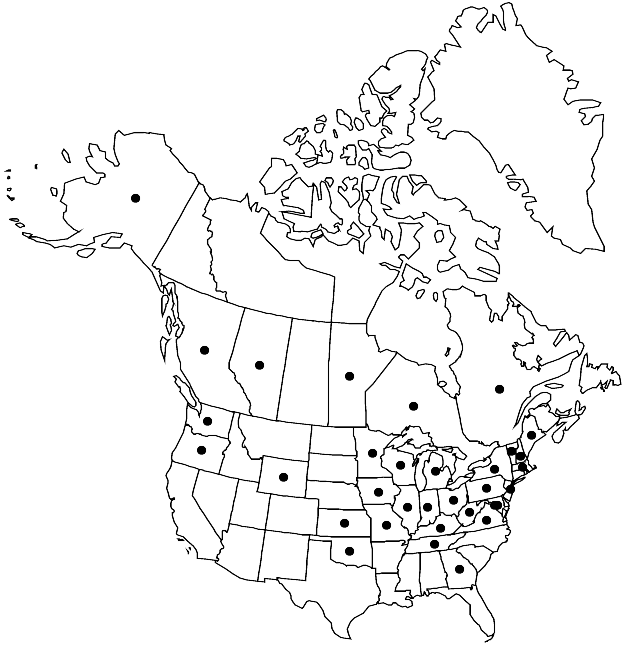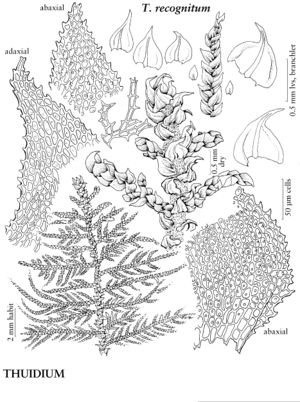Difference between revisions of "Thuidium recognitum"
Not. Sällsk. Fauna Fl. Fenn. Förh. 13: 416. 1874.
FNA>Volume Importer |
imported>Volume Importer |
||
| (5 intermediate revisions by 2 users not shown) | |||
| Line 9: | Line 9: | ||
|special_status={{Treatment/ID/Special_status | |special_status={{Treatment/ID/Special_status | ||
|code=F | |code=F | ||
| − | |label= | + | |label=Illustrated |
}} | }} | ||
| − | |basionyms={{Treatment/ID/ | + | |basionyms={{Treatment/ID/Basionym |
|name=Hypnum recognitum | |name=Hypnum recognitum | ||
|authority=Hedwig | |authority=Hedwig | ||
| + | |rank=species | ||
| + | |publication_title=Sp. Musc. Frond., | ||
| + | |publication_place=261. 1801 | ||
}} | }} | ||
|synonyms={{Treatment/ID/Synonym | |synonyms={{Treatment/ID/Synonym | ||
|name=H. protensum | |name=H. protensum | ||
|authority=Michaux | |authority=Michaux | ||
| + | |rank=species | ||
}} | }} | ||
|hierarchy=Thuidiaceae;Thuidium;Thuidium recognitum | |hierarchy=Thuidiaceae;Thuidium;Thuidium recognitum | ||
| Line 42: | Line 46: | ||
-->{{#Taxon: | -->{{#Taxon: | ||
name=Thuidium recognitum | name=Thuidium recognitum | ||
| − | |||
|authority=(Hedwig) Lindberg | |authority=(Hedwig) Lindberg | ||
|rank=species | |rank=species | ||
| Line 56: | Line 59: | ||
|publication title=Not. Sällsk. Fauna Fl. Fenn. Förh. | |publication title=Not. Sällsk. Fauna Fl. Fenn. Förh. | ||
|publication year=1874 | |publication year=1874 | ||
| − | |special status= | + | |special status=Illustrated |
| − | |source xml=https:// | + | |source xml=https://bitbucket.org/aafc-mbb/fna-data-curation/src/2e0870ddd59836b60bcf96646a41e87ea5a5943a/coarse_grained_fna_xml/V28/V28_599.xml |
|genus=Thuidium | |genus=Thuidium | ||
|species=Thuidium recognitum | |species=Thuidium recognitum | ||
Latest revision as of 21:36, 5 November 2020
Plants light green to yellowish or brownish. Stems 4–9 cm, 2-pinnate, frondose; paraphyllia papillose usually at or near cell ends. Stem leaves ± incurved basally and wide-spreading apically when dry, spreading with reflexed apices when moist, broadly ovate, distinctly plicate, 1 mm; margins plane at least when removed from stem, rarely ± revolute proximally, papillose-serrulate, more strongly so in acumen; apex abruptly acuminate; costa nearly filling acumen but disappearing near apex; distal laminal cells rhombic to oblong-rhombic, to 24 × 8–10 µm. Branch leaves apical cell truncate, multipapillose. Primary branch leaves to 0.5 mm; costa shorter. Secondary branch leaves 0.2 mm; apex acute; costa 1/3–2/3 leaf length. Perichaetial leaves to 4.2 mm, margins denticulate, sometimes dentate or notched near base of acumen. Seta 2–4.2 cm. Capsule 2–3.5 mm; operculum 0.7–1 mm, long-conic or bluntly short-rostrate; endostome cilia in groups of 2 or 3. Spores 11–16 µm, smooth or nearly so.
Phenology: Capsules mature fall–winter.
Habitat: Moist soil, humus, rock, logs, bark at base of trees, calcareous habitats, woodlands, clearings, timber trails
Elevation: low to high elevations
Distribution

Alta., B.C., Man., Ont., Que., Alaska, D.C., Ga., Ill., Ind., Iowa, Kans., Ky., Maine, Md., Mass., Mich., Minn., Mo., N.H., N.J., N.Y., Ohio, Okla., Oreg., Pa., Tenn., Vt., Va., Wash., W.Va., Wis., Wyo., Europe.
Discussion
The specific epithet of Thuidium recognitum was applied by Hedwig because he recognized the many differences that separate the species from T. delicatulum: stem leaves that are shortly, broadly, and abruptly acuminate and plicate, with margins plane or nearly so; costa spreading out and nearly filling the acumen; stem leaf apices wide-spreading from an arched and incurved base; perichaetial leaves eciliate; paraphyllia papillose at or near cell ends; and operculum not or only shortly and bluntly rostrate. The secondary branch leaves of T. recognitum are erect-spreading when dry or moist and have rhombic distal laminal cells, 8–12 × 8–10 µm, that are thick-walled and stoutly 1-papillose with papillae somewhat curved.
Selected References
None.
